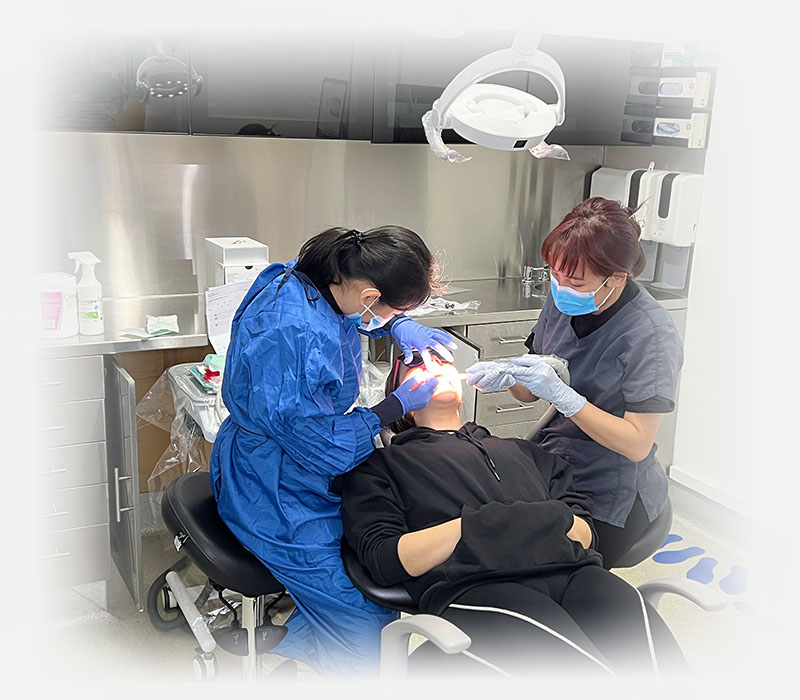Jaw Surgery
Jaw surgery, also known as orthognathic surgery or corrective jaw surgery is where the lower jaw, upper jaw or both jaws are repositioned in order to correct a ‘bad bite’ (malocclusion). It is performed to help correct severely misaligned bites where it’s too severe for orthodontic correction to achieve better facial aesthetics and balance.
Jaw surgery can also correct gummy smiles, where too much gum above the upper incisors when you smile is shown. It can also correct lower jaws, which protrude and take the lower front teeth ahead of the upper front teeth. Jaw surgery can also correct the lower jaw when it’s very short. This can cause the lower front teeth to bite into the soft tissue of the palate behind the upper front teeth, making the palate quite sore.
Jaw surgery can also correct the lower jaw when it’s angled downwards, resulting in a “horsey” or long face appearance. If this occurs, the front teeth won’t be able to bite together at all. Jaw surgery can also correct upper jaws that are positioned too far back, giving the patient a very sunken-in appearance around the base of the notes and a quite concave profile.



What is orthodontic camouflage?
If there is not too much of a mismatch in jaw position, orthodontics can largely camouflage the jaw discrepancy. This is what the orthodontist does for many patients. When there is a significant difference in jaw position, then the position of the jaws needs to be fixed before the teeth can be put in the best position for chewing. Another advantage of repositioning the jaws is that for many people it gives an enormous improvement in profile and appearance.




Who performs jaw surgery?
When it is desirable to position both the teeth and the jaws, the orthodontist works together with another dental specialist, the Oral and Maxillofacial Surgeon. Many of these surgeons are fully qualified medical practitioners as well as specialist dentists. The Oral and Maxillofacial Surgeon performs an operation for the patient in hospital, which repositions either one or both jaws into an improved position. Jaws can be moved in any direction, just as teeth can.




How to know if jaw surgery is needed
Orthodontic treatment is necessary if the teeth, jaws or both are not in the right place. If teeth are crowded or protruding, it can be hard to see if one jaw is positioned further back or forward from the other one. Symptoms and signs specialist orthodontists look for that may indicate jaw surgery is required include:
- Receding chin
- Protruding jaw
- Jaw pain
- Uneven wearing of teeth
- Difficulty chewing or biting food
- Speaking clearly
- Chronic mouth breathing resulting in inflamed gums or dry mouth
- Sleep apnoea and snoring




What happens during jaw surgery?
Jaw surgery is a common procedure performed by an Oral and Maxillofacial Surgeon to improve a person’s ability to chew and speak. This type of surgery can improve jaws that are too small, too large, too far back, too far forward or crooked. Jaw surgery is usually performed in conjunction with orthodontic treatment that to correct bite problems, commonly called “occlusion”.




Our approach to jaw surgery can improve many aspects of your life
By working closely with Oral and Maxillofacial Surgeons, Bayside Orthodontists take a team approach to your jaw surgery. We understand that jaw surgery won’t be for everybody, but the patients who take this step tell us they wish they did it sooner.




What are the jaw surgery treatment phases?
Our jaw surgery treatment is divided into three parts.
Part 1 is the pre-surgical orthodontic phase when braces are fitted to the teeth in order to “de-compensate’ them. This is where we align and level your teeth and place them in the correct angle in the supporting bone. This usually takes 12-18 months of active tooth movement. It’s important to note that by the end of this phase your facial profile and the position of your teeth are liable to look worse rather than better. This is deliberate and unavoidable and is a vital step to prepare for your surgical correction. Part 1 of this phase focuses on undoing nature’s attempt to mask the skeletal discrepancy of your jaws.
Part 2 is the jaw surgery where you’ll have braces still fitted to your teeth. This requires hospital admission where your Oral and Maxillofacial Surgeon will make the necessary surgical corrections to the jaws.
Part 3 is the post-surgical orthodontic phase and usually lasts about 6 months. This is where the final orthodontic detailing and positioning of the occlusion is carried out.















